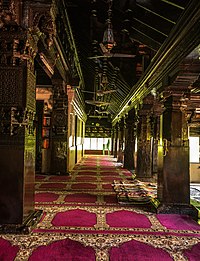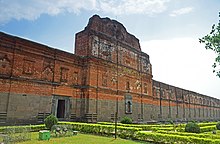
The Delhi Sultanate was an Islamic empire based in Delhi that stretched over large parts of the Indian subcontinent for 320 years (1206–1526). Following the invasion of South Asia by the Ghurid dynasty, five unrelated heterogeneous dynasties ruled over the Delhi Sultanate sequentially: the Mamluk dynasty (1206–1290), the Khalji dynasty (1290–1320), the Tughlaq dynasty (1320–1414), the Sayyid dynasty (1414–1451), and the Lodi dynasty (1451–1526). It covered large swaths of territory in modern-day India, Pakistan, and Bangladesh as well as some parts of southern Nepal.

The Deccan sultanates were five late-medieval Indian kingdoms—on the Deccan Plateau between the Krishna River and the Vindhya Range—that were ruled by Muslim dynasties: namely Ahmadnagar, Berar, Bidar, Bijapur, and Golconda. The sultanates had become independent during the break-up of the Bahmani Sultanate. In 1490, Ahmadnagar declared independence, followed by Bijapur and Berar in the same year. Golconda became independent in 1518, and Bidar in 1528.

The Bahmani Sultanate, was a Persianate Indo-Muslim empire located in the Deccan region. It was the first independent Muslim kingdom of the Deccan, and was known for its perpetual wars with its rival Vijayanagara, which would outlast the Sultanate.

The Qutb Shahi dynasty also called as Golconda Sultanate was a Persianate Shia Islam dynasty of Turkoman origin that ruled the sultanate of Golkonda in southern India. After the collapse of Bahmani Sultanate, the Qutb Shahi dynasty was established in 1512 AD by Sultan-Quli Qutb-ul-Mulk, better known though less correctly referred to in English as "Quli Qutb Shah".
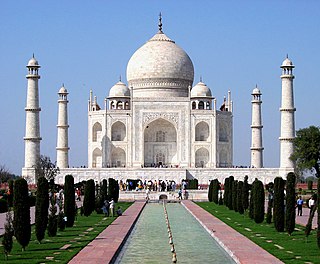
Indo-Persian culture refers to a cultural synthesis present in the Indian subcontinent. It is characterised by the absorption or integration of Persian aspects into the various cultures of modern-day republics of Pakistan, India and Bangladesh. The earliest introduction of Persian influence and culture to the subcontinent was by various Muslim Turko-Persian rulers, such as the 11th-century Sultan Mahmud Ghaznavi, rapidly pushed for the heavy Persianization of conquered territories in northwestern India, where Islamic influence was also firmly established. This socio-cultural synthesis arose steadily through the Delhi Sultanate from the 13th to 16th centuries, and the Mughal Empire from then onwards until the 19th century. Various Muslim dynasties of Turkic, local Indian and Afghan origin patronized the Persian language and contributed to the development of a Persian culture in India. The Delhi Sultanate developed their own cultural and political identity which built upon Persian and Indic languages, literature and arts, which formed the basis of an Indo-Muslim civilization.

Sonargaon is a historic city in central Bangladesh. It corresponds to the Sonargaon Upazila of Narayanganj District in Dhaka Division.

The history of Bengal is intertwined with the history of the broader Indian subcontinent and the surrounding regions of South Asia and Southeast Asia. It includes modern-day Bangladesh and the Indian states of West Bengal and Assam's Karimganj district, located in the eastern part of the Indian subcontinent, at the apex of the Bay of Bengal and dominated by the fertile Ganges delta. The region was known to the ancient Greeks and Romans as Gangaridai, a powerful kingdom whose war elephant forces led the withdrawal of Alexander the Great from India. Some historians have identified Gangaridai with other parts of India. The Ganges and the Brahmaputra rivers act as a geographic marker of the region, but also connects the region to the broader Indian subcontinent. Bengal, at times, has played an important role in the history of the Indian subcontinent.

The Muslim conquests in the Indian subcontinent mainly took place from the 13th to the 16th century. Earlier Muslim conquests in the subcontinent include the invasions which started from what is now modern-day Pakistan, especially the Umayyad campaigns in the eighth century and the resistance to them by the Rajputs.

Indo-Islamic architecture is the architecture of the Indian subcontinent produced by and for Islamic patrons and purposes. Despite an initial Arab presence in Sindh, the development of Indo-Islamic architecture began in earnest with the establishment of Delhi as the capital of the Ghurid dynasty in 1193. Succeeding the Ghurids was the Delhi Sultanate, a series of Central Asian dynasties that consolidated much of North India, and later the Mughal Empire by the 15th century. Both of these dynasties introduced Persianate architecture and art styles from Western Eurasia into the Indian subcontinent.

The Ahmadnagar Sultanate was a late medieval Indian Muslim kingdom located in the northwestern Deccan, between the sultanates of Gujarat and Bijapur. Malik Ahmed, the Bahmani governor of Junnar after defeating the Bahmani army led by general Jahangir Khan on 28 May 1490 declared independence and established the Nizam Shahi dynasty rule over the sultanate of Ahmednagar. Initially his capital was in the town of Junnar with its fort, later renamed Shivneri. In 1494, the foundation was laid for the new capital Ahmadnagar. In 1636 Aurangzeb, then Mugal viceroy of Deccan, finally annexed the sultanate to the Mughal Empire.

The Bengal Sultanate was a Sunni Muslim empire based in Bengal for much of the 14th, 15th and 16th centuries. It was the dominant power of the Ganges–Brahmaputra Delta, with a network of mint towns spread across the region. The Bengal Sultanate had a circle of vassal states, including Odisha in the southwest, Arakan in the southeast, and Tripura in the east. Its raids and conquests reached Nepal in the north, Assam in the east, and Jaunpur and Varanasi in the west. The Bengal Sultanate controlled large parts of the north, east and northeast Indian subcontinent during its five dynastic periods, reaching its peak under Hussain Shahi dynasty. It was reputed as a thriving trading nation and one of Asia's strongest states. Its decline began with an interregnum by the Suri Empire, followed by Mughal conquest and disintegration into petty kingdoms.

The Mughal Empire was an early-modern empire that controlled much of South Asia between the 16th and 19th centuries. For some two hundred years, the empire stretched from the outer fringes of the Indus river basin in the west, northern Afghanistan in the northwest, and Kashmir in the north, to the highlands of present-day Assam and Bangladesh in the east, and the uplands of the Deccan Plateau in South India.
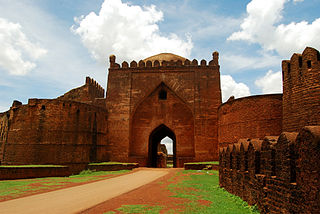
Bidar Fort is a fort located in old city area, Bidar, Karnataka, India. The fort, the city and the district are all affixed with the name Bidar. Sultan Ahmad Shah I of the Bahmanid dynasty shifted his capital from Gulbarga to Bidar in 1427 and built his fort along with a number of Islamic monuments. There are over 30 monuments inside Bidar fort.
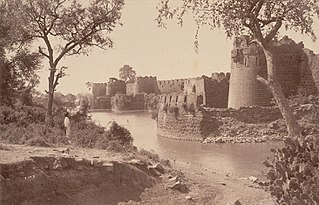
The Gulbarga Fort is located in Kalaburagi in the Kalaburagi district of North Karnataka. It was subsequently significantly enlarged in 1347 by Al-ud-din Hasan Bahmani of the Bahmani Dynasty after he cut off his ties with the Delhi Sultanate; Islamic monuments such as mosques, palaces, tombs, and other structures were also built later within the refurbished fort. The Jama Masjid built later, within the fort, in 1367, is a unique structure built in Persian architectural style, fully enclosed, with elegant domes and arched columns, which is unlike any other mosque in India. It was built to commemorate the establishment of the dynastic rule of the Bahmani kingdom at Kalaburagi fort between 1327 and 1424. It remained the capital of the Bahmani Kingdom till 1424 where after the capital was shifted to Bidar Fort, as Bidar had better climatic conditions.

The Persian language in the Indian subcontinent, before the British colonisation, was the region's lingua franca and a widely used official language in North India. The language was brought into South Asia by various Turkic and Afghan dynasties from the 11th century onwards, notable of which were the Ghaznavids, Delhi Sultanate and the Mughal Dynasty. Persian held official status in the court and the administration within these empires. It largely replaced Sanskrit as the language of politics, literature, education, and social status in the subcontinent.
Hyderabad is the capital of the Indian states of Telangana and Andhra Pradesh. It is a historic city noted for its many monuments, temples, mosques and bazaars. A multitude of influences has shaped the character of the city in the last 400 years.

Bengali Muslims are adherents of Islam who ethnically, linguistically and genealogically identify as Bengalis. Comprising about two-thirds of the global Bengali population, they are the second-largest ethnic group among Muslims after Arabs. Bengali Muslims make up the majority of Bangladesh's citizens, and are the largest minority in the Indian states of West Bengal, Tripura and Assam.

The history of Telangana, located on the high Deccan Plateau, includes its being ruled by the Satavahana Dynasty, the Kakatiya Dynasty (1083–1323), the Musunuri Nayaks (1326–1356), the Delhi Sultanate, the Bahmani Sultanate (1347–1512), Golconda Sultanate (1512–1687) and Asaf Jahi dynasty (1724-1950).

The history of the taka, also known as the tanka or tangka, refers to one of the major historical currencies of Asia, particularly in the Indian subcontinent and Tibet. It was introduced in the 14th century and became a currency of the Silk Road. Its history is intertwined with the medieval Islamic history and culture of the Indian subcontinent.

The Khalji dynasty was the first Muslim dynasty to rule Bengal. The dynasty, which hailed from the Garmsir region of present-day Afghanistan, was founded in 1204 by Muhammad Bakhtiyar Khalji, a Muslim general of the Ghurid Empire. The Khaljis initially pledged allegiance to Sultan Muhammad of Ghor until his death in 1206, though their rule in Bengal was mostly independent. Under the rule of Iwaz Khalji, Bengal experienced major developments such as its first naval force, flood defence systems and linkage with the Grand Trunk Road. The dynasty was based in the city of Lakhnauti in northern Bengal, later expanding eastwards and southwards. Nasiruddin Mahmud, the son of Mamluk sultan Iltutmish of Delhi managed to conquer Bengal in 1227; although the Khaljis briefly reasserted their independence, they surrendered to the Mamluks in 1231, who replaced them with a series of regional governors.

